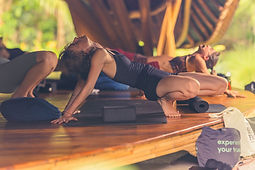🌀🔗 What if alignment isn’t what you think?
- Fanny Alavoine
- Jul 21
- 3 min read

Hey friend,
Sometimes a pose looks perfect from the outside, stable, elegant, even a little holy. 🧘♀️
But inside? There’s little holding it together.
It’s like wearing a really good mask.
From the outside, it looks like presence...
But inside, there’s no breath, no clarity, just 'holding' the mask. Just performing.
That’s what misaligned movement can also feel like: the shape is there, but the action isn’t.
It performs well, but it doesn’t flow.
Okay wow. That got poetic fast. #deep 😅
Let me try again, but with something... lighter:
It’s also like one of those IKEA chairs.
You build it, it looks perfectly stable…
…then you sit on it, one leg wobbles, and you realize something’s off underneath.
You know that one mystery screw left in the IKEA bag?
The one you definitely missed in the instructions but now you’re too far in to fix it?
Well, that screw matters.
It’s the difference between “fine for now” and “stable in a way that actually lasts.”
That’s alignment.
Not just the outer form, but the inner support system: the intentional activation, the use of the bounce & momentum, the smooth connection & communication between parts.
Not for aesthetics. For sensation. For integrity. For function.
Because when the outer form looks “right,” but the inner architecture isn’t supporting it?
Eventually… the wobble shows, just like for the IKEA chair.
💡 Alignment in motion, what it actually means
Let’s drop the idea that alignment is about angles and aesthetics.
It’s not about freezing into a shape.
And it’s not even about symmetry.
It’s about action: subtle, internal, directional action.
And whether that action is truly present, or being 'faked' through compensations, avoidance patterns, habits, gripping, or collapse.
You can have two people in the exact same shape:
👉 In one, the movement flows like water. Everything’s communicating.
👉 In the other, it’s all over-effort and disconnect.
Same shape. Totally different truth.
In functional anatomy terms, alignment in motion is about:
✅ Clear force distribution through the kinetic chain
✅ Balance between effort and ease, support and surrender
✅ Smart sequencing, not just muscle engagement, but timing: using the natural momentum of any dynamic movement.
It’s less about getting into a pose, more about how the pose moves through you.
☕ One of those moments…
I asked a student recently what alignment feels like, and she said:
“Like when the movement goes all the way through.”
That line has stayed with me.
Because alignment isn’t about looking right, it’s about feeling whole.
It’s when the breath, the tissues, the intention all agree.
That’s what we’re after, whether it’s in a Child's Pose or a handstand.
In my practice, I have to laugh (sometimes nervously) at my tendency to get lazy with my core. 😅 Sometimes, I rely on ligament tension and external support instead of engaging my muscles properly. It’s like my body says, “Core, you’ve got this,” and I’m over here like, “But what if I just chill in a hammock instead? 🦥” (Spoiler: that doesn’t work long term.)
When I skip the muscle connection, I will eventually feel the wobble, the instability that reminds me I’m not doing the work. For me, it’s easy to slip into that lazy shortcut, but when I actually engage from within, the difference is clear: more stability, integration, and flow.
But sometimes, I swing to the other extreme: overdoing it, over-tensing, especially in my jaw and feet. It’s like I try to compensate for my lazy core by gripping elsewhere.
The thing is, it’s not the same pattern every day. Our compensation habits change based on energy, mindset, and life experiences. They’re personal, and they’re linked to how we move through life, both physically and emotionally. Thus... exploring these patterns in the body is more than just movement work: it’s really a gateway to understanding ourselves on a deeper level.
This is where effort drops away. Where your movement feels like it comes from your essence, not your outer body. That’s the heart of flow. 🌀
We don’t want you to move prettier.
We want you to move more honestly.
🔗 Come if you’re ready to move from the inside out.
👉 Learn more or save your spot
With core-led curiosity and IKEA humility,
Fanny











Comments